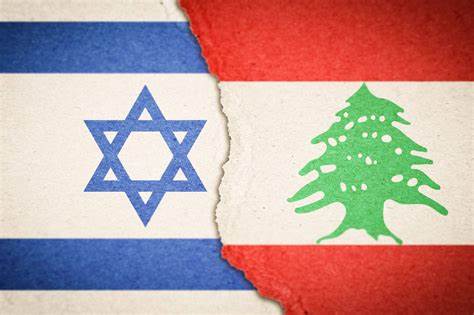
Lebanon Engulfed in Conflict as Israeli Airstrikes Intensify
ahrammonline
In recent days, Israel has escalated its military operations in Lebanon, particularly targeting Hezbollah strongholds in the south and eastern Beqaa Valley. The situation on the ground has rapidly deteriorated, with many observers considering it a full-scale war, even though official declarations have not been made. The bombardment of southern Lebanese towns and villages has been relentless, with hundreds of strikes each day. This has led to the destruction of roads, effectively isolating these regions from the rest of the country and forcing thousands of civilians to flee northward.
Despite debates in international and national security circles about whether the situation should be termed a “war,” the reality on the ground speaks for itself. Retired Lebanese General Wehbe Katicha has called the conflict “a full-scale war,” describing how it has evolved in phases since the initial attack by Hamas on Israel on October 7. What started as rocket exchanges between Israel and Hezbollah has now escalated into daily airstrikes, with the number of casualties growing. This third phase, Katicha asserts, is the most devastating, with over 500 casualties reported in a single day of Israeli strikes.
The intensifying conflict has raised questions about the possibility of an Israeli ground incursion into Lebanon. Though Israel has not yet initiated such an operation, signs indicate it may be on the horizon. The Israeli Northern Command has warned that forces must be prepared for a ground offensive, with two reserve battalions already recruited. The goal would likely be to secure Israel’s northern border and enable displaced civilians to return to their homes. Major General Ori Gordin of the Israeli Northern Command has emphasized that the focus has been on significantly degrading Hezbollah’s capabilities, including its rocket systems and leadership.
The conflict has deeply affected the civilian population in Lebanon. Southern Lebanon, in particular, has been the epicentre of intense fighting, with homes and infrastructure damaged or destroyed by airstrikes. Roads have been blocked or destroyed, leaving only perilous routes available for civilians trying to flee to safer areas. In recent days, Israel has issued warnings to civilians to evacuate homes suspected of being used by Hezbollah to store weapons. Flyers dropped by Israeli forces in the Beqaa Valley gave civilians just two hours to evacuate their homes, and there have been unverified claims that these flyers included codes that could compromise mobile phones.
Lebanese civilians have been caught in the crossfire, dealing with both physical destruction and psychological trauma. Eyewitnesses describe terrifying scenes as rockets and bombs rain down on their communities. In one instance, civilians reported seeing ordnance explode in mid-air after an airstrike, further endangering those on the ground. Adding to the tension, Israel has reportedly been able to disrupt radio frequencies in Lebanon to broadcast warnings about impending airstrikes. This capability has shocked many Lebanese civilians, highlighting the technological gap between the two sides.
The conflict raises serious questions about Hezbollah’s ability to sustain its resistance against Israel. Khalil Helou, another retired Lebanese general, has labelled the conflict a “full-scale attrition war” and doubts whether Hezbollah can maintain the fight. He notes that Israel has proven capable of sustaining long-term attrition warfare, while Hezbollah may lack the resources and resilience to continue. Although Hezbollah possesses a large arsenal of missiles capable of striking Israeli territory, Israeli airstrikes have significantly weakened its leadership and infrastructure, potentially hampering its ability to respond effectively.
Daniel Byman, a senior fellow specializing in terrorism and warfare at the International Institute for Strategic Studies, believes that Hezbollah is on the defensive. While the group can still launch attacks against Israel, its internal communication and strategic capabilities may be compromised by the Israeli strikes. Israel’s precision in targeting Hezbollah’s leaders and key assets has left the group scrambling to adapt. However, Byman also cautions that there is much about Hezbollah’s current situation that remains unknown, leaving room for unexpected developments.
The looming question is whether Israel will launch a ground invasion of Lebanon. While Israeli officials have not confirmed such plans, the potential for an invasion remains a key concern. Katicha, the retired Lebanese general, hopes it can be avoided, as it would escalate the conflict further and result in even greater destruction. However, he acknowledges that the decision will ultimately depend on whether Israel feels it has achieved its strategic objectives through airstrikes alone. If the Israeli government concludes that a ground incursion is necessary to secure its northern border and bring stability to the region, such an operation may become inevitable.
In conclusion, while international leaders and military experts debate the semantics of what constitutes “war,” the situation in Lebanon has already reached that threshold for many civilians. With homes destroyed, roads blocked, and lives uprooted, the Lebanese people are facing the brutal realities of an ongoing and intensifying conflict. As the situation unfolds, the potential for a ground invasion looms large, and the prospect of a prolonged war of attrition between Israel and Hezbollah seems increasingly likely. For now, the region remains engulfed in uncertainty and fear, with no clear end in sight.



